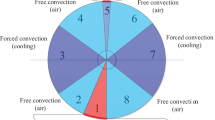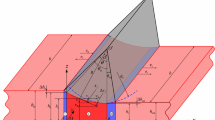Abstract
A new sine velocity field is proposed to analyze total power in the roll gap for rolling in hot strip finishing mill. The field and linear geometric midline yield criteria are used to calculate the plastic deformation power, and the collinear vector inner product method is used to get friction power. Then analytical equation of strip rolling power functional is obtained. Finally, the roll force and torque can be calculated by minimizing the power functional. In the model, average deformation resistance is determined by the thermo-mechanical coupled analysis. The prediction accuracy of the proposed model is examined through comparing with the on-line measured results in a hot strip finishing mill. It shows that the predicted roll forces are in good agreement with the measured ones, and the maximum error is less than 12 %. Moreover, the effects of various rolling conditions, such as thickness reduction, friction factor, and shape factor, on roll force, location of neutral angle, and stress-state coefficient are discussed systematically.










Similar content being viewed by others
Abbreviations
- b :
-
Strip width
- c s :
-
Specific heat of the steel
- \(D\left( {\dot{\varepsilon }_{ij} } \right)\) :
-
Power per unit volume
- F min :
-
Minimum value of rolling force
- F, dF :
-
Friction surface area and an infinitesimal area on it
- h 0, h 1 :
-
Half of the initial and final strip thickness at entrance and exit
- h m :
-
Half of the mean strip thickness in the roll gap
- h mf, h mb :
-
The mean thickness of strip in forward and backward slip zones
- h x (h α ):
-
Half of the strip thickness in deformation zone
- h x ′:
-
The first-order derivatives of h x
- \(h_{{\alpha_{n} }}\) :
-
Half of the strip thickness at position of neutral angle
- Δh :
-
Half of the absolute reduction
- J*:
-
Total power
- k :
-
Yield shear stress
- k c :
-
Roll contact heat flow coefficient
- k d :
-
Deformation efficiency coefficient
- k f :
-
Friction efficiency coefficient
- l :
-
Projected length of roll-strip contact arc
- m :
-
Friction factor
- M min :
-
Minimum value of roll torque
- n σ :
-
Stress-state coefficient
- N :
-
The first-order derivative equation of U
- \(\bar{p}\) :
-
Rolling force per unit roll-strip contact area
- R :
-
Radius of work roll
- T entrance :
-
The strip temperature at entrance
- T exit :
-
The strip temperature at exit
- T s :
-
Strip temperature
- T r :
-
Work roll temperature
- U :
-
The flow volume per second
- v 0, v 1 :
-
Velocity of strip at entrance and exit
- v x , v y , v z :
-
Velocity components in x, y, z directions
- v R :
-
Roll circumferential velocity
- v Rx , v Rz :
-
Velocity components of work roll in x, z directions
- ∆v f :
-
Discontinuous quantity of tangential velocity
- ∆v x , ∆v y , ∆v z :
-
The components of ∆v f in x, y, z directions
- x N :
-
Projected length between neutral point and entrance
- \(\dot{W}_{\text{i}}\) :
-
Deformation power
- \(\dot{W}_{\text{f}}\) :
-
Friction power
- \(\dot{W}_{\text{s}}\) :
-
Shear power
- \(\dot{W}_{s0}\) :
-
Shear power at entrance
- α, β, γ :
-
Direction angles formed by \(\tau_{f}\) and the coordinate axes in x, y, z directions
- α n :
-
Neutral angle
- χ :
-
Lever arm
- ɛ :
-
Equivalent strain
- \(\dot{\varepsilon }_{ij}\), \(\dot{\varepsilon }_{\hbox{max} }\), \(\dot{\varepsilon }_{\hbox{min} }\) :
-
Strain-rate tensor and its maximum and minimum values
- \(\dot{\varepsilon },\dot{\varepsilon }_{x} ,\dot{\varepsilon }_{y} ,\dot{\varepsilon }_{z}\) :
-
Equivalent strain rate and the components of strain rate in x, y, z directions
- θ :
-
Bite angle
- ρ s :
-
Density of the steel
- σ s :
-
Yield stress
- τ f :
-
Frictional stress on the roll-strip contact surface
- τ fx , τ fy , τ fz :
-
Components of \(\tau_{f}\) in x, y, z directions
References
Nishino S, Narazaki H, Kitamura A, Morimoto Y, Ohe K (2000) An adaptive approach to improve the accuracy of a rolling load prediction model for a plate rolling process ]. ISIJ Int 40(12):1216–1222
Oh SI, Kobayashi S (1975) An approximate method for a three-dimensional analysis of rolling. Int J Mech Sci 17(4):295–305
Kato K, Murota T, Kumagai T (1980) Flat-rolling of rigid-perfectly plastic solid bar by the energy method. Jpn Soc Technol Plast 21(231):359–369
Li GJ, Kobayashi S (1984) Numerical analysis of forming processes. Wiley, San Francisco
Park JJ, Oh SI (1990) Application of three dimensional finite element analysis to shape rolling processes. J Eng Ind 112(1):36–46
Kim N, Kobayashi S, Altan T (1991) Three-dimensional analysis and computer simulation of shape rolling by the finite and slab element method. Int J Mach Tools Manuf 31(4):553–563
Yea Y, Ko Y, Kima N, Lee J (2003) Prediction of spread, pressure distribution and roll force in ring rolling process using rigid–plastic finite element method. J Mater Process Technol 140(1–3):478–486
Kobayashi S, Oh SI, Altan T (1989) Metal forming and the finite element method. Oxford University Press, Oxford
Luis CJ, Le´On J, Luri R (2005) Comparison between finite element method and analytical methods for studying wire drawing processes. J Mater Process Technol 164(3):1218–1225
Zhao DW, Zhang SH, Li CM, Song HY, Wang GD (1991) Rolling with simplified stream function velocity and strain rate vector inner product. J Iron Steel Res Int 2012 19(3):20–24
Deng W, Zhao DW, Qin XM, Gao XH, Du LX, Liu XH (2010) Linear integral analysis of bar rough rolling by strain rate vector. J Iron Steel Res Int 17(3):28–33
Zhang SH, Zhao DW, Gao CR (2012) The calculation of roll torque and roll separating force for broadside rolling by stream function method. Int J Mech Sci 57(1):74–78
Ali Nuri D (2001) On constructing kinematically admissible velocity fields in cold sheet rolling. J Mater Process Technol 110(3):287–299
Zhao DW, Wang GJ, Liu XH, Wang GD (2008) Application of geometric midline yield criterion to analysis of three-dimensional forging. Trans Nonferrous Met Soc China 18(1):46–51
Wang GJ, Du HJ, Zhao DW, Liu XH, Wang GD (2009) Application of geometric midline yield criterion for strip drawing. J Iron Steel Res Int 16(6):13–16
Zhao DW, Li CM, Lan LY, Zhang SH (2011) Application of GM yield criterion in plastic zone of mode I crack and burst pressure for pipeline. Adv Mater Res 399–401:2189–2194
Wang GD, Zhao DW (2004) Modern materiel forming mechanics, 1st edn. Northeastern University Press, Shenyang, p 32
Sun YK (2002) Hot strip rolling model and control, 1st edn. Metallurgical Industry Press, Bei**g, p 49
Sherstnev P, Flitta I, Sommitsch C, Hacksteiner M, Ebner T (2008) The effect of the initial rolling temperature on the microstructure evolution during and after hot rolling of AA6082. Int J Mater Form 04(1):395
Gong DY, Xu JZ, Peng LG (2007) Self-learning and its application to laminar cooling model of hot rolled strip. J Iron Steel Res Int 14(4):11
Kang YL (2006) Control on microstructure and properties of casting and rolling steel products of thin slab, 1st edn. Metallurgical Industry Press, Bei**g, pp 104–107
Acknowledgments
The authors gratefully express their appreciation to National Nature Science Foundation of China (No.: 51074051), the Fundamental Research Funds for the Central Universities (No.: N140704001), and the PhD Start-up Fund of Natural Science Foundation of Liaoning Province, China (No.: 20131033), for sponsoring this work.
Author information
Authors and Affiliations
Corresponding author
Additional information
Technical Editor: Alexandre Mendes Abrao.
Rights and permissions
About this article
Cite this article
Ma, GS., Liu, YM., Peng, W. et al. A new model for thermo-mechanical coupled analysis of hot rolling. J Braz. Soc. Mech. Sci. Eng. 39, 523–530 (2017). https://doi.org/10.1007/s40430-015-0390-9
Received:
Accepted:
Published:
Issue Date:
DOI: https://doi.org/10.1007/s40430-015-0390-9




